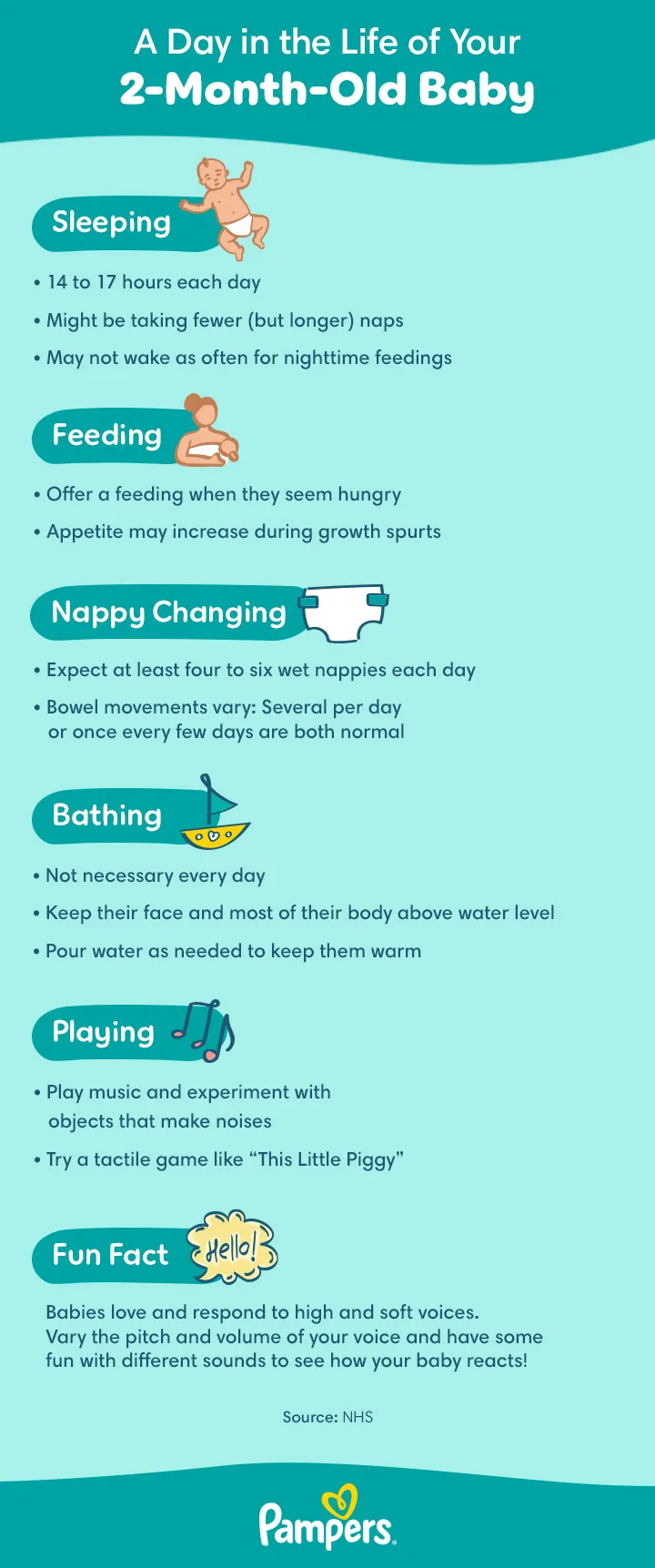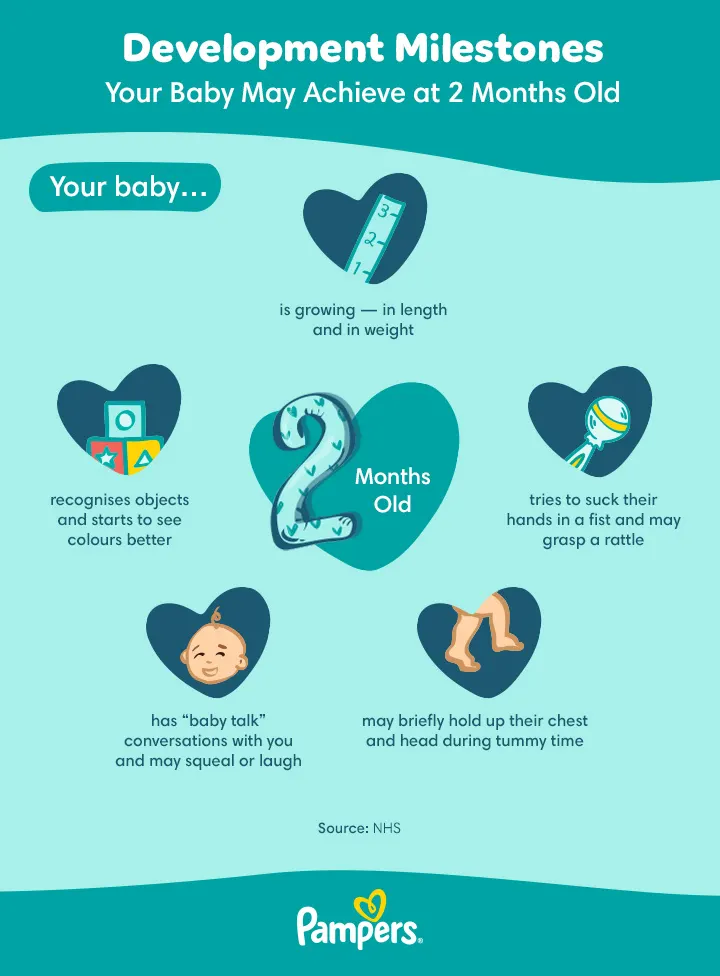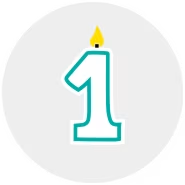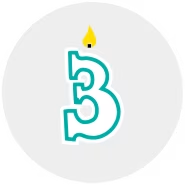2-Month-Old Baby Development: Happiness and Comfort in Familiar Faces
Have you noticed that your tiny newborn isn't so tiny anymore? There are many exciting growth and developmental milestones to look forward to once your baby turns 2 months old, and we’re providing a preview of some of the ones you’ll definitely want to watch for. We also cover how to deal with common health concerns like nappy rash and coughs. If you're planning your return to work soon, we also have a section on things to keep in mind so that this transition goes smoothly for both you and your baby.
Baby Development Milestones for a 2-Month-Old
This month will be full of discovery for your baby, as your little one becomes more and more aware of the world around them. Here are some of the baby development milestones your 2-month-old baby may be approaching.
Growth and Physical Development
During these early months, newborns grow most rapidly. Your health visitor, child centre or GP will monitor your baby’s growth rate at each checkup, noting your 2-month-old baby’s weight, length and head circumference to make sure that your little one is on track and doing well. Read more about how baby growth charts are used in your baby’s first 24 months.
Movement: Gaining Strength
Although many of your baby’s movements are still reflexive, your little one will gradually learn to control more of what they do. As you play together, you are contributing to developing your little one’s brain and muscle power. Whether playing peek-a-boo, clapping or wiggling on the floor, your baby is setting the foundations for future physical and cognitive development.
When laying on their back, you may notice your baby is wiggling, waving their arms and legs about, and kicking more this month.
All that tummy time your baby's been putting in (with you closely supervising) will slowly start to pay off. Around this month or next, your little one will be able to push up off their arms, and briefly hold their chest and head up. This is big news because it’s a step toward greater independence for your little one. Gaining this skill will mean being able to look around at anything that grabs your little one’s attention, even when lying on their tummy.
Senses: Making Eye Contact
At 2 months old, your baby’s vision is improving. They will start to recognise objects and will love to look at familiar human faces, especially their parents’. You might even notice them deliberately making eye contact with you or following objects or people of interest with their eyes.
In earlier weeks, your baby may have been drawn to simple patterns with straight lines, but soon they'll start to notice circular shapes and patterns such as bull's-eyes and spirals. Your little one is starting to see colours better, too.
Personality: ‘Baby Talk’
Your baby’s personality will reveal itself more and more each day. For example, if you smile at your little one they might smile right back at you. Around this time, your baby might start to have fun by making all kinds of strange new sounds. You might hear muh-muh and bah-bah, and aahs and oohs. Have conversations with your little one by repeating these sounds back to them.
‘Baby talk’ is important at this stage, but add in real words, too. All along, your little one will be learning that conversation is a two-way street where each person takes turns and each contribution is important. As the weeks progress, your baby will be more alert to your tone of voice, and may sense your mood by how you talk to them. Your voice also helps signal what’s to come, so tell your little one what you’re doing when you’re changing their nappy, when it’s time for a walk or while you’re bathing your baby.
Activities to Support Your 2-Month-Old Baby’s Development
Playing and interacting with you has a huge role in your baby’s brain development and early learning. Here are some play activities you could do with your 2-month-old baby:
Read to your baby. Even if your baby doesn’t fully understand all the words, they’re still listening to the sounds you’re making. Don't hesitate to read the same book over and over – babies love repetition. For more tips on reading to your baby, take a look at this summary about language development through ‘baby talk’.
Have a chat. Respond to your baby’s coos and aahs, and initiate conversation by telling them what you’re up to. When your little one ‘talks’, try not to interrupt or look away. Your attention sends out a signal that your baby’s voice is important too, and helps build trust.
Continue tummy time. Continue to give your baby short periods of tummy time each day to help strengthen the neck, arm and shoulder muscles. Tummy time involves laying your baby on their tummy on a firm surface like the floor – just make sure you’re watching.
Introduce a variety of sounds. Play your baby music or give them toys that make different sounds when touched. Let your little one listen to the sounds of everyday life, too. For example, have them safely nearby as you do housework – the sound of you tidying will probably fascinate your baby.
Feeding Your 2-Month-Old Baby
How much should a 2-month-old eat in 24 hours, and what’s a recommended feeding schedule? Feed your baby whenever they’re hungry – which will be often, as 2-month-old newborns usually eat about 8 to 12 times in 24 hours. Signs that your little one is ready to eat might include making sucking motions, moving a hand to their mouth, whimpering or flexing their arms and hands.
Avoid overfeeding your baby by keeping an eye out for the signs of being full, such as slowing down or stopping sucking or turning away. At this stage, you might be able to leave out one middle-of-the-night feed; as your baby’s stomach capacity grows they may not be hungry again until early morning.
Tracking Wet and Dirty Nappies
The number of nappies you change gives you a clue about whether your baby is healthy and getting enough to eat. So, how many wet and dirty nappies should a 2-month-old have? Keep in mind that each baby is unique and may wee anywhere from once every couple of hours to only once every four to six hours. Pay attention to how many nappies your baby typically goes through. If there is a significant drop in the number of wet nappies or your baby’s mouth seems dry, your little one could be dehydrated. If you’re in any doubt, consult your baby’s GP.
There is no ‘right’ number when it comes to pooey nappies either. Two-month-old babies can poo anywhere from several times a day to only once a week. If your baby is pooing less than normal but the poos are soft and your baby is otherwise well, there may not be cause for concern. Still, if you’re worried, your baby’s health provider will be able to check whether everything is OK.
You can find out more in our article on how often you should change a nappy.
A 2-Month-Old’s Sleep Schedule: How Much Sleep Do They Need?
At 2 months old, your baby may now start spending more time alert and awake during the day than as a newborn, and although they may want fewer sleeps, they might be a little longer in duration. At this stage some (but not all) babies even manage to sleep for longer periods during the night, before waking to feed or because it’s too hot or cold. A baby around 2-months-old should generally get about 14 to 17 hours of sleep in a 24 hour period (including naps).
Good bedtime routines give your little one a great start in life, contributing to their general health and well-being. Although it can take a while for evening routines to become established, you can help your 2-month-old head in the right direction by making night-time feeds as quiet as possible. For example, keep the lighting low, don’t speak much or loudly and after the feed and a quick nappy change put them back to sleep on their back.
Get Help Setting Up a Sleep Routine for Your 2-Month-Old
To help you establish a consistent and personalised bedtime routine for your little one, check out the Smart Sleep Coach by Pampers. Codeveloped with paediatric sleep experts, the Smart Sleep Coach app includes a powerful sleep tracking tool that suggests the best times for your baby to nap and sleep. It can help you track your baby’s sleep patterns and recommend ways to improve their sleep routine, as well as guide you on how to soothe them and create a better sleep environment.
A Day in the Life of Your 2-Month-Old Baby
Your 2-month-old baby’s daily schedule may include simple routines for sleeping, feeding, bathing and playing. Here’s one example of what a typical day might look like:
Your Baby’s Health
Here are some health conditions you might come across this month:
Nappy rash. A wet or soiled nappy that touches baby skin for too long can cause a red rash on the nappy area. To combat nappy rash, change wet or pooey nappies as soon as possible, clean the area with wipes at each change and expose your baby’s bottom to air whenever possible. These steps will help the rash clear up and help prevent it from reoccurring.
Heat rash or prickly heat. These tiny, red bumps typically occur in hot and humid weather, usually on the neck, arms, legs or nappy area. Don’t apply skin ointments; instead, cool the area with water, then completely dry the skin, dress your baby in cool, dry clothing and try to keep them out of the heat. With this kind of care, heat rash typically goes away after a few days.
Eczema. If your baby has red, itchy, scaly patches of skin in the crooks of the elbows and knees, it could be eczema. Your baby’s GP can make a diagnosis and will recommend treatment options. It may help to use mild, unscented baby soaps on your baby and on all your little one’s clothes and sheets. Dress them in soft clothes that don’t prickle and keep the number of baths down to three times a week at the most.
Coughing. If you notice your 2-month-old newborn coughing, it’s a sign that their airways are irritated. Coughs can be triggered by many kinds of respiratory illnesses, from the common cold to pneumonia. It’s a good idea to call your baby’s doctor if your little one is coughing, but if coughing is accompanied by fever or difficulty in breathing take your baby to the GP right away for treatment or advice.
Allergies. Potential signs of a food allergy or sensitivity include if your baby seems fussy or cries excessively, is sneezing, wheezing and coughing, has a runny nose, has red, itchy eyes or develops a rash. Your baby’s GP will need to explore potential causes and make a diagnosis.
Development Tips for Your Baby This Month
Here are some tips that may help you bond with your 2-month-old baby and foster a feeling of safety and security, as well as contribute to their well-being and emotional development:
Provide warm and consistent physical contact. Hugging your baby often makes them feel safe and loved. Continued skin-to-skin contact is also important.
Read to your baby every day. Reading helps set the stage for language development in babies. Reading in the evening before bed is also the perfect opportunity to create a calming bedtime routine.
Narrate your day as you talk to your baby. Use simple-to-understand phrases to narrate your actions as you interact with your baby, such as during dressing, nappy changes, bathing and feeding times. Respond to your baby’s faces and gestures because it’s in fact a conversation! If you or your partner speak a foreign language, use it with your baby.
Show your baby colourful objects of different shapes, sizes and textures. These can include sensory toys, rattles or soft toys (be sure the toys are suitable for a 2-month-old infant). You may also like to show your baby picture books and family photo albums.
Get in tune with your baby’s mood. You know your baby best: their preferences and aversions. Read and respond to their cues, for example, when they're hungry or tired, happy or upset.
Items You Will Need This Month
You may already own some baby essentials like a cot, changing table and buggy, but here are some additional items that may be worth purchasing if you haven’t already:
Baby books. Now’s the time to dig out your favourite children’s book from your childhood or repurchase some of the classics and some of the latest titles.
Sound machine. If your baby needs help falling asleep, you might like to try using very soft music or white noise to help lull them to sleep.
Nappies, wipes, and nappy rash cream. You’ll continue to use a lot of nappies in the coming months, so being well-stocked with nappying supplies is a good idea.
Baby nail clippers. You may be surprised how fast your baby’s fingernails grow. Baby nail clippers can make trimming them a breeze.
Humidifier. A comfortable sleeping temperature and humidity is very important for your baby, especially if they happen to have a cold.
Night-light. A night light will make those late-night feedings and check-ins much easier, and you won’t wake up your baby by turning on an overhead light.
Baby thermometer. A thermometer specifically designed for babies is a must-have. Plus, make sure that your first-aid kit is up to date.
FAQS AT A GLANCE
At 2 months old, you might notice your baby turn their head side to side when lying on their stomach, wave arms and legs, kick, touch their face, hold a toy briefly and follow objects with their eyes. They may also start to make cooing sounds, maintain eye contact and smile in response to you talking or smiling at them.
Your Life as a Parent: Returning to Work
Depending on your situation, different factors may come into play as you decide if and when to go back to work, including your finances, maternity leave options and general family considerations. If you can, allow yourself some flexibility as you may change your mind about your return to work when the time comes. Whether getting additional help at home or taking your little one to a nursery, the key is to find childcare that you feel comfortable with and that your baby thrives under.
Organising Childcare
You may have multiple sources and forms of childcare, which you could consider, including
your parents or other relatives
a registered childminder or nursery
in-home care, either solely for your baby or in a group with other children
a nanny
or a combination of the above.
As you search for childcare, keep in mind that the most important thing is to make sure your baby is happy and developing well under the care you select. Ask other parents or your baby’s health visitor, clinic or GP for referrals.
Expressing Breast Milk at Work
Returning to work can be stressful for some parents and may reduce your breast milk supply (as may other sources of stress), particularly if you are unable to pump as much as you would like. Workplace regulations require that your employer must allow you time and a space – other than a bathroom – for you to express breast milk. If you are concerned your milk supply may be running low, read up on how to increase breast milk supply and contact your health visitor or GP for help.
Checklist for This Month
Here’s a handy checklist to help you get by this month:
If you’re returning to work, finalise your childcare plans.
Create a list of a few trusted childminders through your local Family Information Service.
If you haven’t already been, schedule your infant’s routine 2-month-old checkup that includes vaccinations. During these regular checkups your baby’s health visitor, GP or child centre will track your baby’s growth, do a physical exam, ask you how you are doing, answer any of your questions and schedule or give any immunisations and vaccinations your baby may need.
Start looking ahead – check out what kinds of things may happen when your baby is 3 months old.
Download the Pampers Club App to earn free nappies.
2 month old baby - checklist
How We Wrote This Article The information in this article is based on expert advice found in trusted medical and government sources, such as the National Health Service (NHS). You can find a full list of sources used for this article below. The content on this page should not replace professional medical advice. Always consult medical professionals for full diagnosis and treatment.





